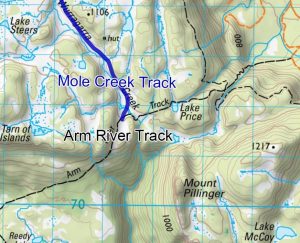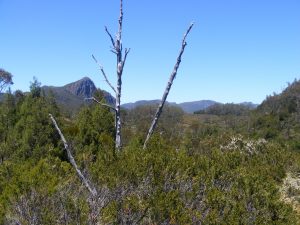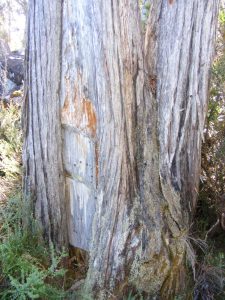There was a large blaze in the side of a pencil pine beside a small stream. That was no surprise, Ian and I were following an old marked track. But Ian thought that the blaze was special.

We had turned off the Arm River Track and were following the old Mole Creek Track along Wurragarra Creek. This was a well-made track when it was formed in 1898, during the middle of the ‘Railway Wars’. It was supposed to link the rural districts of central Tasmania with the emerging mines of the West Coast. The route was long and tortuous from Liena on the Mersey through the high country to Rosebery. Ultimately it was a failure.

The track was overgrown but we found some of its hidden features along the way. Things like: a rock cairn with a broken stake, a culvert or two, lots of benching and fords across the small side creeks. This part of the track hadn’t been used much since the 1940s.[1] Often the scrub on the track was thicker than on the surrounding hillside. An unfortunate problem with benching is that it tends to hold water which helps nature reclaim and obscure the track.

We hit a particularly thick patch of scrub which slewed us towards more open ground. That’s when we crossed the little side creek and Ian found the axe marks in the tree. The pencil pine was right on the edge of the stream, its roots almost in the water. The blaze had cut away the bark and deep into the wood. It was a big old scar.
At first, I couldn’t understand why Ian was getting so excited. As we walked to the Tarn of Islands (we blogged about this before) we talked it over. We untangled the many clues; the blaze itself, where it was located and the history of tracks in the area. The result was as astonishing as Ian said.

The blaze was cut in three large steps. The first was at least 24 cm long (9”), the second about 34 cm long (13”) and the last disappeared into the foliage below. The rings of the tree were still clearly visible. The axe that cut the tree was very sharp and struck with solid blows. It must have been a well maintained tool.
It was also a very big blaze. Far bigger than any marking tracks. Most are a single swing of the axe or even tomahawk to mark a path. Any decent bushman doesn’t need a blaze of this size to navigate.
The blaze faced the stream. Was it to show a crossing point?
The blaze was old. The bark had healed and closed in along the sides but it had elongated as the tree slowly grew.
The history of tracks in the area gives important clues.
There only had been one track made down this valley. The Mole Creek Track. It was formed in 1898 by the Public Works Department under Overseer Richard Broomhall. But the track crossed the creek a good distance further upstream at a ford made of stones. The blaze did not mark the Mole Creek Track. But there was one other option.
The route for the Mole Creek Track was surveyed in 1896. The survey line was marked. The surveyor in charge Edward George Innes stated that ‘All timber within easy reach is marked upon either side with a large blaze or horseshoe mark’.[2] When a creek was crossed it was ‘well and plainly marked’ by directional signs with directions, called finger posts, nailed to a tree.[3]
The other significant clue is that the track did not strictly follow the survey line. Overseer Broomhall was allowed to deviate from the line surveyed by Innes when he could improve the track or make construction easier.[4]
It appears that the big old blaze was made as part of the survey. If it was, we can be a little more precise and say that it was made by one of the two workers on the survey, Bradshaw or Rowe in November of December 1896.[5] But the blaze is more remarkable than that.
In my decades of searching the line of the Mole Creek Track and the Innes Survey, I have never found a single remnant of the survey. Not a stake, stump, cairn, blaze or any other feature made during the survey is visible along the 120 km of the route. What makes this one blaze exciting is that it probably the only physical reminder of the months of hard work done by Innes and his survey team. The blaze marks the last feature of the route long called the Innes Track.
Copyright Mountainstories.net.au 2019
[1] Nancy Shaw and Vic Crawn, The Innes Track, Liena to Rosebery, Tasmanian Tramp, 1948, 33.
[2] Innes, E. (1897). Route to the West. Papers of the House of Assembly of Tasmania, 43: Hobart, Tas.
[3] Ibid.
[4] Prichard, F., Launceston Examiner, ‘Westward Ho! The Mole Creek Track No.3’ 24 March 1898.
[5] “Westward Ho! Mr. Russell’s Report”, Launceston Examiner, December 11, 1896.
Hello,
Edward Innes was my Grandfather. I would love to walk his track. I found out about it a few years ago when it was found again.
He was long gone before I was born, we don’t know a lot as the Innes family are quite old and the old don’t talk all that much about the past.
If you have any further reading on the track etc, I would be interested.
Thank you for writing this small piece, the family are quietly proud of the history they have in Tasmania. I’ll be sharing the link with his eldest living daughter who resides in Hobart.
The Innes family have an impressive history. It is a shame that they were not celebrated in your family. Edward George was a diligent and hard working surveyor. There is a thesis about the track at this web address. https://eprints.utas.edu.au/19322/ It has been a pleasure to look into this great part of Tasmanian history and the people that made it happen.
Hi Janet,
I’m guessing that you are a daughter of Edward David Ballantyne Innes? My grandfather was Athol Innes of Cygnet. I’m very interested in Innes family history. Perhaps you could email me directly and we could catch up?
Edward was my great grandfather. I published a biographical article about him in Tasmanian Ancestry volume 22 number 3 2001 p 153 https://www.tasfhs.org/downloads/Volume22Number3_2001.pdf. There are a few of his letters in the Tasmanian Archives Office. I have transcribed them and other family letters in the collection. Hoping one day to publish them in some form.
I have noticed the occasional historian confusing Edward George Innes with his uncle, George Innes, who was also a surveyor but only in the south east of the state. Interestingly several descendants have been surveyors, including my brother, mainland born and bred, but who spent several years as a government surveyor in Tasmania.
Thank you for this article. I’m probably never going to hike the track myself but it is good to see the photos and read about the blaze.
Thank you for your comments Louise. It was good to ready your article. Peter
Thank you for sharing this information. Edward Innes (2011- USA- CA) is a descendent and is now doing research about his surname and the man he was named after. Super Informative! Thank You!